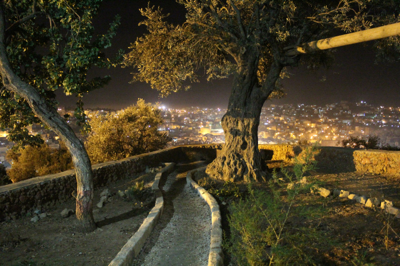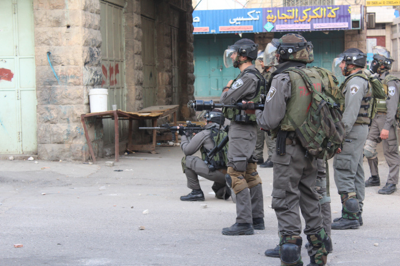
While walking through the market in Hebron a Palestinian greets us and asks as where we’re from. Straight away he invites us back to his home where he introduces us to his wife and serves us tea, perhaps an oddly familiar way to treat strangers in the West but Palestinians are known for being incredibly hospitable and as internationals it’s rare to walk through the city without being ushered into someone’s home or shop and offered food and drink.

He tells us about his family and the problems he has with the settlers, devout Zionists who believe they have an entitlement to Palestinian land which they usually take by force with the assistance of the Israeli army. It’s a flagrant breach of international law and is condemned as illegal by the UN, the International Court of Justice and every respected human rights organization but Israel’s support from the US means that nothing is ever done to enforce this.
Most Palestinians have had problems with the settlers but the story we hear today is one of the worst. He shows us the scorch marks on his building where the settlers threw molotov cocktails and his eyes start watering as he tells us about his son who went down into the market to buy sweets one day when some of the settlers threw chlorine at his face, blinding him.
Aggression from the settlers is hardly unusual and the city has its own international peacekeeping forced called the ‘Temporary International Presence in Hebron’, although the ‘temporary’ part is questionable as they’ve been around since 1994. TIPH’s job is to monitor breaches of international law and hostility from both the settlers and the Palestinians.
Hebron is the largest city in the West Bank and like most built up Palestinian areas it’s under constant threat as a result of Israel’s illegal occupation.
While the city is indisputably part of Palestine, in 1967 the Israeli army seized control of it all, later withdrawing from all but 20%. The result is that the entire East side including the historic old city and the Ibrahim mosque has been annexed by the Israeli army and border guards and the city is divided into two areas, the Palestinian controlled H1 and the Israeli controlled H2.

The area where the two zones meet is understandably volatile and the Israeli army maintains a high level of security. Shuhada Street, used frequently for both Palestinians and Israelis has been divided in two, with most of the road being forbidden for Palestinians who must instead walk along a small section at the side. Just one of the many policies of apartheid in the West Bank that the UN and many human rights groups have criticised Israel for.
Palestinians passing into H2 to pray at the Ibrahimi mosque must go through humiliating checkpoints where they are often searched harassed. The checkpoints are under strict Israeli control and can be closed at a moments notice. As the occupying force, Israel has a duty to protect the Palestinians under the fourth Geneva Convention. The fact that people are freely allowed to walk from the Israeli area into the Palestinian one but when it’s the other way round they’re subject to strict security measures suggests otherwise.
One evening we were invited into the Youth Against Settlements centre, a non-violent Palestinian activist group that campaigns against the continually spreading illegal Israeli settlements. The land borders settler homes and so it receives constant harassment. Olive trees are damaged and the centre has been vandalised so often that the UN paid for metal security shutters. Elsewhere in the city there’s a field of olive trees that have been doused in petrol and set alight.
There have certainly been cases of settlers injured or even killed in the city but these are far less frequent and the settlers are always under the protection of the army and border police who are notorious for their incredibly light touch intervention when Palestinians are the victims.
The worst clash between Palestinians and the settlers in recent history was the Cave of the Patriarchs massacre in 1994 when an American born settler walked into the Ibrahim mosque with an assault rifle during prayer and slaughtered 29 worshipers and injured 129 others, only stopping when he ran out of ammo and was subsequently beaten to death. The anniversary of this event is still celebrated by some of the settlers.
There’s still a huge amount of resentment felt towards the occupiers and understandably so but all of the confrontations I’ve seen here so far have been between the heavily armed and armoured border police and Palestinian children who are bored and angry with Israel’s apartheid and throw stones and rocks at the soldiers.
Tensions have been made worse by Israel’s indiscriminate fire into Gaza and Saturday and Sunday saw crowds of children gather to throw rocks at the checkpoints and military gates, a fairly common occurrence. What happened over these days was a battle of tear gas, sound grenades and rubber bullets against stones thrown by kids hiding in backstreets, the soldiers occasionally advancing further through the streets of the Old City.
It’s obvious how big a part of their life it is by the casual way the treat the skirmish. Many of the older teenagers seemed impervious to the tear gas fired at them while others fell on the floor crying.
At one point Jeff, an ISMer from America and I were blocked off from the rest of the group by the gas which was still being launched our way. One of the children brought us to a nearby shop for coffee break before we walked back towards the soldiers. The tear gas, which can linger for as long as 10 minutes on a windless day, has become as unexciting as it is annoying.
I’d constantly heard how just watching the soldiers as internationals as well as standing in the vicinity of those they were targeting can make the situation a lot safer and I got to see this firsthand. At the start of the skirmish children were throwing stones off a rooftop at the armour and helmet wearing soldiers. They approached the crossroad and fired a volley of tear gas onto the rooftops and then one lay on the ground and started calibrating the scope of his sniper rifle.
We have no idea whether this was just for show, to fire warning shots or worse but another soldier turned and saw one of us filming then shouted at the sniper who stood up and lowered his gun.

It went back to tear gas after this with the occasional firework set off by the children. It died down after a while and we left. Sometime later we heard that the soldiers had evicted 30 Palestinians from their homes and were making them line up outside the checkpoint. Nobody knew what any of these people had done and they were seemingly chosen at random by the soldiers who were annoyed by not having arrested any of the stone throwers earlier. Wyatt and I walked to the checkpoint where they were being detained. Some of the Christian Peace Team workers told us that they’d all been released apart from four, two of whom had been driven elsewhere. We could see one of the remaining captives through a gap in the gate, handcuffed and blindfolded. Five minutes later they were both released. A soldier had asked one if he loves Israel. When he said no the soldier took a hundred shekels from him and let them go. They’re seventeen and nineteen years old and they both shrugged the whole event off like it was nothing new for them. It isn’t.
Sunday night saw a repeat of before except this time there were more soldiers. Towards the end of the evening a fairly large crowd of the kids were throwing stones at checkpoint 56 which connect the Israeli occupied H2 with the Palestinian H1. The Palestinian police force tried to keep them back until the border police decided they’d had enough and stormed through into H1, firing canisters of tear gas directly into the crowd (banned by the army’s central command which claims it never happens). A thirteen year old boy named Ibrahim Abu Eisheh was hit in the back of the head by one of them as he was running and had to be taken to hospital. It turns out he’s the cousin of someone that visits our flat occasionally. The last we heard he was in critical condition.
All text, images and opinions by Ed Knight.
Ed Knight is currently living in Palestine and volunteering with the International Solidarity Movement, a non-violent, Palestinian led group that seeks to stand in solidarity and raise awareness of the effects of the occupation.

Leave a Reply